
Theme 2: Multiscale models
Research under the Multiscale Models research theme is concerned with modelling the structure of systems at various hierarchical levels and understanding the relationship between these levels.
This can occur, for example, in statistical models where the interest is in methodology that can calibrate the model to real data, stochastic process models where the focus is on how models scale under different regimes and in random matrix models that have become very prominent in the last couple of years in studies of many body quantum chaos and information scrambling in black holes.
ACEMS’ work under Multiscale Models theme covers a remarkable breadth, ranging from various types of queueing models, models for the Bitcoin blockchain, biological models involving epidemics, tissue growth and malaria infections, stochastic lattice models involving multi-variable polynomials, statistical mechanical models of traffic flow in urban transport networks, economic models involving matching behaviour, models for market equilibria, models for stochastic control, linear mixed models and models of bore water supply.
The Numbers
Researchers
Cross-node collaboration groups
industry and international collaboration projects
People
Key Achievements
Mathematical and statistical models for many systems of interest can naturally be developed at different levels of detail, or at different scales. In 2020 research groups across ACEMS worked to understand the relationships between these different scales.
CI Jan de Gier submitted a paper on observables of coloured stochastic vertex models and their polymer limits, with Professor Alexei Borodin of the Massachusetts Institute of Technology, USA. This foundational paper is likely to become influential and lead to several spin-off projects. He also progressed research on the two-species totally asymmetric exclusion process and derived the multi-particle Green's function for this stochastic process, as well as an exact formula for a total crossing event.
Significant progress was made on a significant and extended version of the de Gier group 2018 "Physical Review Letters" article on multi-species exclusion processes. A very deep and intricate mathematical paper with collaborators in Tokyo is nearing completion.
CI de Gier and his group also continued work on the deep mathematical understanding of fluctuations arising out of emergent behaviour in interacting many-particle systems. A large detailed manuscript on multi-species exclusion processes with collaborators from Tokyo, including Zeying Chen, is nearing completion.
CI de Gier and Research Fellow Sasha Garbali (who received an ARC Discovery Early Career Research Award in the 2020 round) submitted a pre-print on the R-matrix of the quantum toroidal algebra. This is a highly complex but topical research area in mathematical physics and pure mathematics. An explicit representation of R would likely lead to a class of integrable 2+1 dimensional stochastic particle processes that then can be mathematically analysed in great detail to provide fundamentally new insights into the form of probability distribution functions for such processes. Current understanding to such depth is limited to 1+1 dimensional processes.
CI de Gier continued research on the relationship between stochastic lattice models and multi-variable polynomials. This interplay led to deep new fundamental insights in the underlying mathematical properties of such polynomials and vice versa, providing new tools to analyse properties of stochastic processes through the development of mathematically tractable (dual) observables that contain pertinent information relevant to applications in biology, physics and other disciplines.
He commenced the co-supervision of a new PhD student from Sri Lanka on the topic of duality observables for stochastic processes.
The research of CI Peter Forrester focused on finding relevance of multiscales in random matrix theory to two very topical areas in theoretical physics, namely many body quantum chaos and information scrambling in black holes. This work has motivated a paper, "Quantifying dip-ramp-plateau for the Laguerre unitary ensemble structure function", submitted to Communications in Mathematical Physics.
CI Forrester ran a weekly Zoom seminar series, and joining forces on this enterprise with the random matrix theory group at the University of Bielefeld, Germany. Guido Mazucca from Scuola Internazionale Superiore di Studi Avanzati, Trieste, Italy was invited to speak as part of the seminar series and this interaction led to a collaboration between CI Forrester and Guido Mazzuca resulting in a paper titled "The classical β-ensembles with β proportional to 1/N: from loop equations to Dyson's disordered chain" which is to be submitted for publication.
Long standing ACEMS Research Fellow, Jesper Ipsen received an ARC Discovery Early Career Research Award for his work on stability in complex systems and network landscapes.
CI Phil Pollett developed fast simulation methods for spin systems, models that are ubiquitous in physics, chemistry, and biochemistry. These methods offer considerable improvements in speed over standard Monte Carlo methods. An important aspect of this work is a detailed error analysis.
CI Pollett studied a class of metapopulation models where there is no ceiling on the number of habitat patches that can be occupied, examining the limiting behaviour as the density of patches increases. These limits are not only natural in theory, but in practice as well, as they describe models with increasing environmental fidelity.
He also studied aggregation in host-parasite populations, exploring the mathematical relationships between various indices used to measure departure of the parasite distribution from well-known distributions.
Research developing deterministic approximations of the Gibbs sampler for the posterior from a two component mixture model was also commenced by CI Pollett.
A cross-node collaboration between CIs Pollett and Peter Taylor, together with AI Laleh Tafakori, brought its work on modelling the growth of tissue in a developing foetus using a scaled composition of dependent Yule-Furry processes to a conclusion. The team have submitted a paper reporting on this work.
In other work involving biological modelling, University of Melbourne undergraduate student Somya Mehra, remarkably, had her second paper published in the Bulletin of Mathematical Biology in collaboration with CI Taylor, University of Melbourne colleagues Jennifer Flegg and James McCaw, and Monash colleague Mark Flegg. Somya extended her previous 2020 model for how malaria hypnozoites develop in the human liver to the situation where multiple hypnozoites can be injected by more than one mosquito bite and commenced her Masters in 2020.
CI Louise Ryan developed sophisticated predictive models for bore water levels, as a function of rainfall, temperature, ocean surface temperature and other predictors. A paper on this work will shortly appear in a special issue of the journal "International Statistics Review". This was the result of an invitation to be part of a special issue of the journal looking at the relationship between classical statistical approaches with recently developed machine learning strategies.
In the study, CI Ryan used multiscale statistical models which allow for the careful time-series modelling of data measured from a single aquifer, whilst incorporating the fact that there are multiple different aquifers in each river basin.
CI Matt Wand derived usable and precise asymptotics for generalized linear mixed model analysis and D-optimal design. He also developed scalable streamlined mean field variational Bayes algorithms for fitting and inference for linear mixed models containing large numbers of cross-random effects.
Together, CIs Ryan and Wand analysed data from a genome-wide association study of individual trends in bone mineral density carried out in Dubbo, New South Wales. Linear mixed models with non-standard random effects structure played an important role.
Cardiac fibrosis is one of the important drivers of life-threatening arrhythmia, and notably is well-established as a key part of why ageing hearts perform more poorly and are more susceptible to signalling dysfunction. CI Burrage, together with several international collaborators in Brazil and at the University of Oxford, U.K., have brought the technique of homogenisation by volume averaging to cardiac fibrosis, incorporating the micro-scale effects of fibrotic obstruction into larger-scale models that are computationally feasible. The work significantly extends the use of homogenisation in the context of cardiac electrophysiology.
ACEMS members continued to collaborate closely with the research team led by James Doecke in our Partner Organisation, CSIRO, to develop statistical methods to better understand and manage Alzheimer’s Disease. This work was led by ACEMS PhD student Zoe van Havre and CSIRO Research Fellow and former ACEMS member Marcela Cespedes, with supervisors from both CSIRO Data61 and QUT. Zoe’s research, which also also included an international colleague, Professor Judith Rousseau (Universite Paris Dauphine, France and University of Oxford, UK), focused on the use of mixture models to identify pre-clinical disease in cognitively normal participants. The multiscale nature of this model lies in the mixture representation and probabilistic allocation of subjects to subgroups with different pre-clinical profiles.
The degeneration of the human brain is a complex process, which often affects certain brain regions due to healthy aging or disease. This degeneration can be evaluated on regions of interest (ROI) in the brain through probabilistic networks and morphological estimates. Current approaches for finding such networks have limitations. ACEMS members CI Kerrie Mengersen, AIs James McGree, Chris Drovandi and other collaborators proposed model to overcome these limitations. It was applied to analyse longitudinal data from healthy control and Alzheimer’s disease groups and found differences that play a crucial role in lasting cognitive impairment. The analyses presented in this work will help practitioners jointly analyse brain tissue atrophy at the ROI‐level conditional on neuropsychological networks, which could potentially allow for more targeted therapeutic interventions.
In collaboration with the Queensland State Government, ACEMS research assistant Abhishek Varghese worked with an international team of researchers on a project to develop a new stochastic model for within-field disease dynamics of biosecurity pests. The multistate nature of the model lies in its ability to describe both short and long-range transmission across spatially correlated small areas, allowing for changes over time. The model was used to predict the spread of a severe pest, banana bunchy-top virus, and is currently being adapted to describe the spread of COVID-19.
A number of PhD students and researchers in ACEMS have been working on the development of spatial and spatio-temporal models for a range of diseases including cancer and dengue. For example, international ACEMS PhD student Aswi Aswi focused on spatio-temporal prediction of dengue in Indonesia, which is important for government agencies in her home country. The multilevel component of these models arises because of the spatial correlation between geographic areas.
Research Fellow David Warne is one of many ACEMS researchers who are employing their mathematical and statistical skills to model and predict the trajectory of cases and deaths of COVID-19 in Australia and across the world. David recently completed his PhD and has been working on a number of multiscale modelling problems. One of these is the development of an epidemiological model that describes the response to the initial COVID-19 outbreak for 158 countries, with the aim of analysing the overall effect of interventions and community responses. The approach, which was developed in collaboration with an international team comprising researchers from the UK and Italy, is based on a stochastic epidemiological model including a feedback mechanism on virus transmission to capture nonlinear dynamics arising from continuous changes in community behaviour in response to rising case numbers. The research explicitly showed the importance of both strict containment measures and broad testing.
ACEMS PhD student, Raiha Browning, has also reoriented her research to support the effort in modelling the trajectories of COVID-19 deaths. Raiha has been studying the theoretical properties of discrete-time nonparametric Hawkes processes, a form of self-exciting process in which a current event impacts on the probability of future events. These models have been employed in numerous applications, including neuroscience, seismology, terrorism and epidemics. Raiha worked with an international team of researchers from the UK and France to examine the capability of a simple Hawkes process to describe daily counts of deaths in ten countries that differed with respect to the spread of the virus and corresponding response measures. The model was able to capture the dynamics of the processes and provided unique insights into global patterns, thereby demonstrating that simple statistical models can sometimes adequately represent complex phenomena. Raiha also presented her research at the ACEMS annual retreat on her International Mobility Program visit.
PhD student Punya Alahakoon worked with her supervisors CI Taylor and James McCaw to apply hierarchical Bayesian methods to assess whether different subpopulations can be modelled by continuous-time Markov chains driven by identical parameters or whether the differences in behaviour between sub-populations are sufficient for us to conclude that the driving parameters must be different. She applied the results to determine the probability of epidemic fadeout in the first trough of an SIS model.
Hritika Gupta, a coursework masters student jointly supervised by CI Taylor and AI Mark Fackrell is looking at correlation between epidemics that are driven by the same contact process. This has application to the question of whether we can make inferences about the course of an epidemic if we have exact knowledge of the original infective’s `contact tree’.
CI Taylor, AIs Rhys Bowden and Paul Keeler and South African colleague Tony Krzesinski continued their work on the engineering aspects of blockchain technology. In an effort to design a blockchain capable of producing an increased transaction rate they asked the effect would be on forking behaviour if the block mining rate were substantially increased. Current indications are that this would result in the different miners being unlikely to be in consensus. However, an exciting result of the research is that the lack of consensus is restricted just to the very recent structure of what is now a blocktree rather than a blockchain.
With their PhD students, Wang and Karunarathne, CI Taylor and AI Fackrell looked at two different aspects of queueing models. Jiesen Wang’s PhD research looks at strategic customer behaviour in feedback queueing model. In a paper that has been accepted into Queueing Systems, they demonstrated that paradoxical behaviour can occur in the sense that there are situations where an increase in the reward received by customers on service completion can result in everyone being worse off. A similar phenomenon can occur if customers are allowed to renege that is leave the queue before completing their service. Wathsala Karunarathne has been designing optimal schedules of customers into a service facility that can also accept a random stream of `walk-in’ customers. With international collaborator and ACEMS Scientific Advisory Committee member Michel Mandjes and his collaborators AV Mahes and Marko Boon, CI Taylor has also been looking at a different type of queue that also has scheduled customers.
In collaboration with Professor Mark Holmes at the University of Melbourne, CI Taylor noticed that paradoxical behaviour can also occur in nearly-completely decomposable continuous-time Markov chain models. In such models there is a small parameter for which the expected hitting times when the parameter is zero are different from what is observed as the parameter approaches zero.
CI Taylor, AI Jing Fu and their colleague Bill Moran published a landmark paper in Operations Research showing how to apply multi-armed restless bandit techniques to complex bandwidth allocation problems. They followed this up with a paper in Stochastic Models in which they applied the ideas to the problem of virtual network design in distributed computer networks where users arrive needing temporary access to central processing unit and peripheral resources plus communication links to connect them.
Economic models involving matching and strategic decision making are the research fields of PhD students Niknami and Xing, both supervised by CI Taylor. Behrooz Niknami is extending some recently-discovered reversibility techniques to the situation where some nodes can be benevolent and using them to study the stability of matching models with a first-come-first-served matching discipline. He hopes to establish stochastic comparison arguments to bound the performance of models that apply the `best available match’ strategy. After looking at multi-armed bandit models from a mechanism design perspective, Chenchen Xing has moved to looking at matching models from a strategic customer perspective.
With his international colleagues Jevgenijs Ivanovs from Denmark and Guy Latouche from Belgium, CI Taylor’s work on fluctuation identities for Markov additive processes has continued.
Finally, CI Taylor ended up becoming a supervisor of a University of Sydney PhD student Chunxi Jiao who he met at the 2020 ANZIAM Conference (one of the last conferences held in person before the advent of COVID-19). Chunxi’s supervisor had taken up a new position at another university and she was left without senior advice in the crucial last year of her project. Chunxi submitted her thesis Semidefinite Relaxations for a Linear Programming Approach to Exit-time Stochastic Control in Dec 2020, and it is a matter of great pride to both her and CI Taylor that the thesis was passed with glowing positive comments from both examiners.
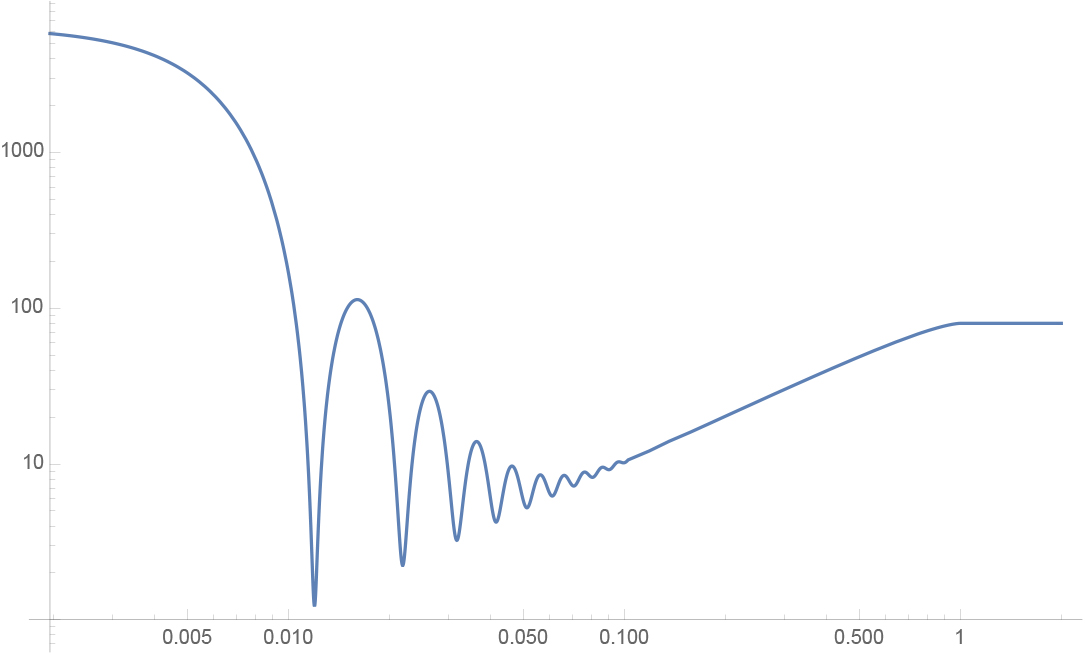
Figure 1: Dip-ramp-plateau for the structure function of the Gaussian unitary ensemble.
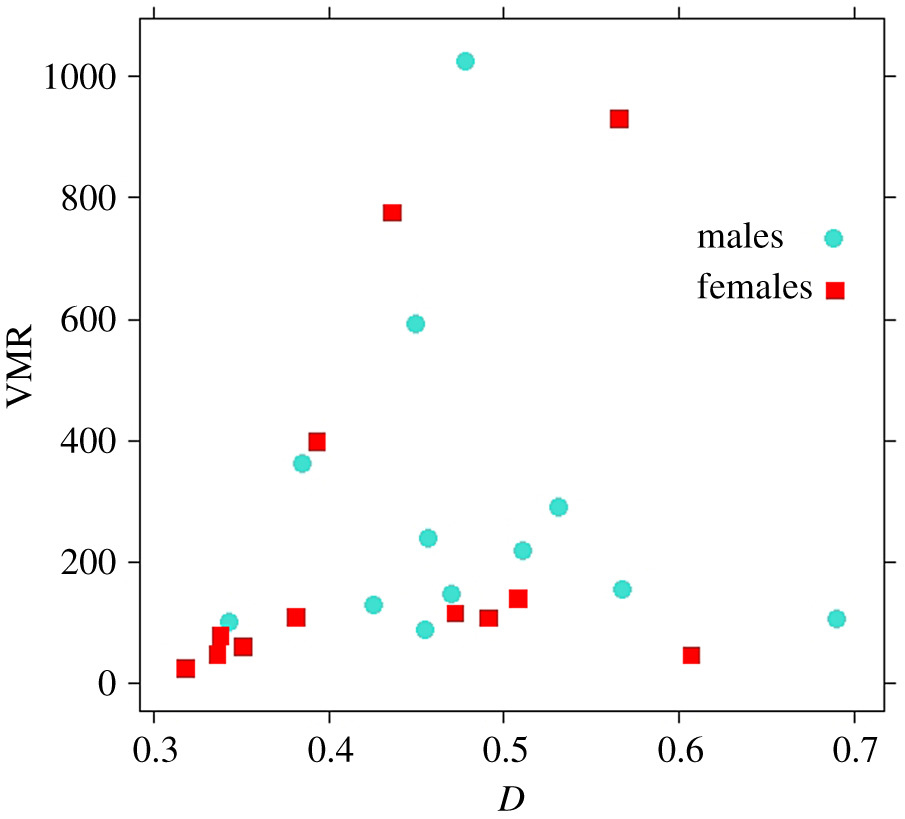
Figure 2: Plot of the index of dispersion (variance-to-mean ratio) against the Gini index (Poulin's D) calculated on samples of helminth parasites from the great cormorant (Phalacrocorax carbo) data. There is no distinguishable pattern, contrary to what one would expect if the two indices measured the same quantity.
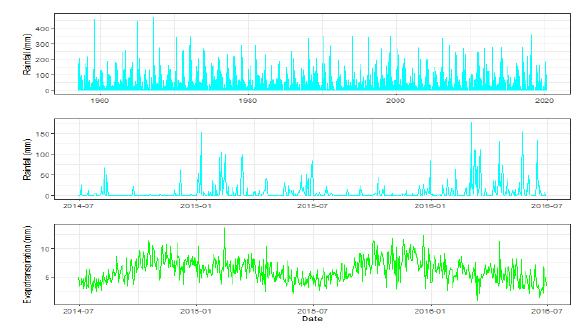
Figure 3: From the International Statistical Review paper by Clark, Hyndman, Pagendam and Ryan paper showing 63 years of rainfall data from Tully, Queensland, one of the wettest places in Australia. The bottom two panels show a closeup of data since 2014, with not only rain but also evapotranspiration, thought to be an important predictor of aquifer levels.
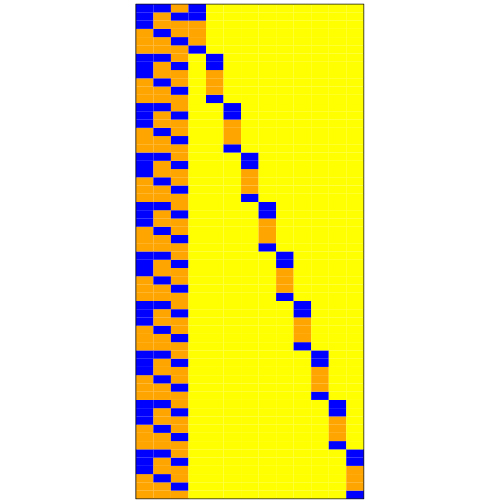
Figure 4: Image plot of a two-level design matrix arising in linear mixed models with crossed random effects of sizes 10 and 2. Blue indicates non-zero entries. Yellow indicates zero entries which contribute to two-level sparse structure. Orange indicates zero entries which do not contribute to two-level sparse structure.

Figure 5: In a model of the electrical waves that trigger the heartbeat, the activation delay (AD) caused by a fine-scale funnel-shaped blockage is recovered by a homogenised model. Potentially arrhythmia-triggering events of one-way conduction block (grey) are also correctly predicted, despite the loss of fine-scale shape information.
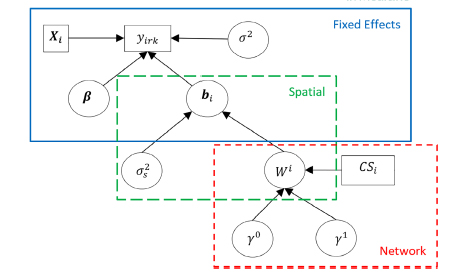
Figure 6: Visualisation of the brain dynamic wombling model describing temporal changes in spatial connections in a brain network which can inform the progression of Alzheimer’s Disease (Cespedes et al, 2020 in Statistics in Medicine).
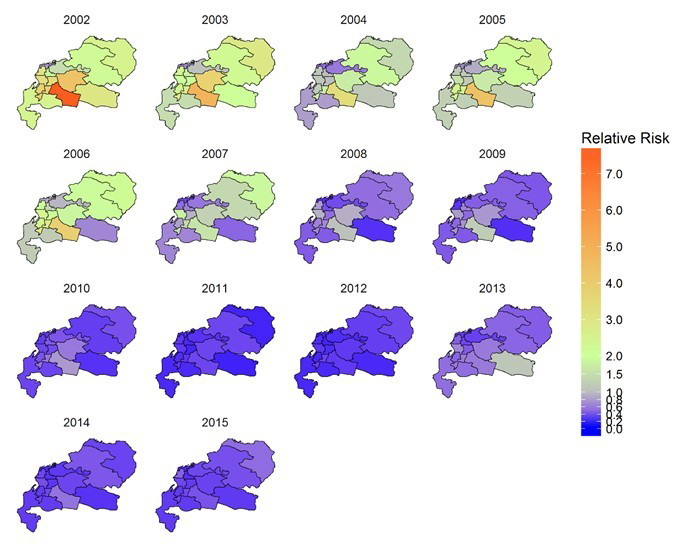
Figure 7: Estimates of the spatio-temporal patterns of relative risk of dengue in Makassar, Indonesia (Aswi et al., 2020).
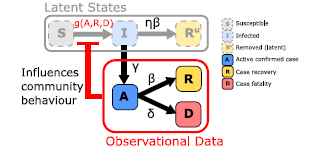
Figure 8: Schematic of epidemiological model fit to COVID-19 trajectories by Warne et al. (2020). The model includes observed data, the influence of community behaviour such as lockdowns, and latent states that govern transmission of the virus.
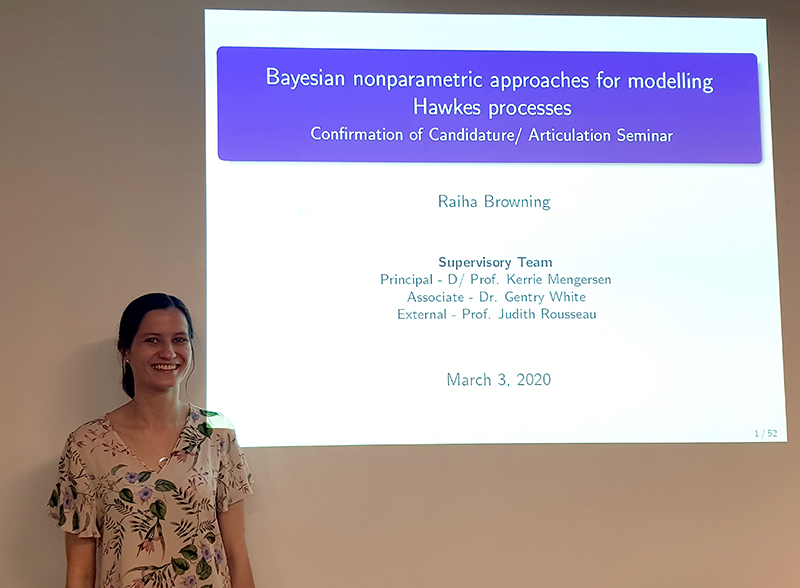
Figure 9: Raiha Browning showcasing her research.
Plans for 2021
Plans for 2021 are already well underway, and the following is a brief summary of what ACEMS researchers across Australia are planning to do:
- Submit article on work detailing and exploring homogenisation in the context of cardiac fibrosis (Burrage)
- Continue research into the connection between Koornwinder polynomials and the exclusion process (de Gier)
- Continue to search for an integrable and mathematically tractable 2+1 dimensional stochastic particle model (de Gier)
- Venture into the development of universal probability distribution functions for quantum systems (de Gier)
- Use integral systems theory to study the sub-leading asymptotics of the longest increasing subsequence problem from the theory of stochastic combinatorial models in the Kardar-Parisi-Zhang universality class (Forrester)
- Complete two further papers in the Garoni, Zho and Deng series on the random-length random walk, and its application to finite-size scaling in high-dimensional statistical mechanics (Garoni)
- Meet with VicRoads colleagues to discuss the results of the Rajapaksha thesis concerning correlations between tram travel times and Bayesian model calibration (Garoni)
- Study occupancy processes with infinitely-many sites (Pollett)
- Develop multilevel Monte Carlo methods for spin systems (Pollett)
- Develop methods to predict water levels into the long term future, say 100 years, under various climate change scenarios (Ryan)
- Develop methodology and software for generalized linear mixed model fitting and inference using Thouless-Anderson-Palmer adjustments to Gaussian variational approximation (Wand)
- Extend results concerning usable and precise asymptotics for generalized linear mixed models analysis beyond the canonical link situation (Wand)
- Continue research on spatio-temporal and self-exciting models (Mengersen)
- Continue research on global and national modelling of COVID-19 data. (Mengersen)
- Submit our work detailing and exploring homogenisation in the context of cardiac fibrosis (Lawson, Burrage)
- Submit a paper on fluctuation identities for lattice and non-lattice Markov Additive Processes (Taylor)
- Submit a paper on optimal scheduling of customers in queues with walk in customers (Taylor, Fackrell and Karunarathne)
- Investigate further aspects of strategic customer behavior in queueing models (Taylor, Fackrell, Wang and Xing)
- Submit a paper on first-come-first-served matching models with benevolent nodes (Taylor, Niknami)
- Continue to work on Bayesian hierarchical modelling of epidemic processes, including submitting a paper on the application of the methods to simulated data (Taylor, Alahakoon)
- Extend our investigation of the use of concentrated matrix exponential distributions in the improvement of direct Galerkin methods for anaysing stochastic fluid models (Taylor, Lewis, Bean)